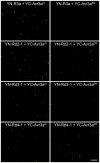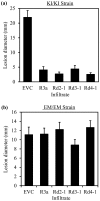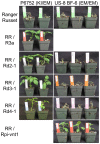Detection of the virulent form of AVR3a from Phytophthora infestans following artificial evolution of potato resistance gene R3a
- PMID: 25340613
- PMCID: PMC4207746
- DOI: 10.1371/journal.pone.0110158
Detection of the virulent form of AVR3a from Phytophthora infestans following artificial evolution of potato resistance gene R3a
Abstract
Engineering resistance genes to gain effector recognition is emerging as an important step in attaining broad, durable resistance. We engineered potato resistance gene R3a to gain recognition of the virulent AVR3aEM effector form of Phytophthora infestans. Random mutagenesis, gene shuffling and site-directed mutagenesis of R3a were conducted to produce R3a* variants with gain of recognition towards AVR3aEM. Programmed cell death following gain of recognition was enhanced in iterative rounds of artificial evolution and neared levels observed for recognition of AVR3aKI by R3a. We demonstrated that R3a*-mediated recognition responses, like for R3a, are dependent on SGT1 and HSP90. In addition, this gain of response is associated with re-localisation of R3a* variants from the cytoplasm to late endosomes when co-expressed with either AVR3aKI or AVR3aEM a mechanism that was previously only seen for R3a upon co-infiltration with AVR3aKI. Similarly, AVR3aEM specifically re-localised to the same vesicles upon recognition by R3a* variants, but not with R3a. R3a and R3a* provide resistance to P. infestans isolates expressing AVR3aKI but not those homozygous for AVR3aEM.
Conflict of interest statement
Figures






Similar articles
-
The C-terminal half of Phytophthora infestans RXLR effector AVR3a is sufficient to trigger R3a-mediated hypersensitivity and suppress INF1-induced cell death in Nicotiana benthamiana.Plant J. 2006 Oct;48(2):165-76. doi: 10.1111/j.1365-313X.2006.02866.x. Epub 2006 Sep 12. Plant J. 2006. PMID: 16965554
-
Expression of a modified Avr3a gene under the control of a synthetic pathogen-inducible promoter leads to Phytophthora infestans resistance in potato.Plant Biotechnol J. 2025 May;23(5):1683-1701. doi: 10.1111/pbi.14615. Epub 2025 Mar 9. Plant Biotechnol J. 2025. PMID: 40059336 Free PMC article.
-
Cloning and characterization of r3b; members of the r3 superfamily of late blight resistance genes show sequence and functional divergence.Mol Plant Microbe Interact. 2011 Oct;24(10):1132-42. doi: 10.1094/MPMI-11-10-0276. Mol Plant Microbe Interact. 2011. PMID: 21649512
-
Genetic factors encoding resistance to late blight caused by Phytophthora infestans (Mont.) de Bary on the potato genetic map.Cell Mol Biol Lett. 2004;9(4B):855-67. Cell Mol Biol Lett. 2004. PMID: 15647802 Review.
-
Understanding and exploiting late blight resistance in the age of effectors.Annu Rev Phytopathol. 2011;49:507-31. doi: 10.1146/annurev-phyto-072910-095326. Annu Rev Phytopathol. 2011. PMID: 21663437 Review.
Cited by
-
Identification and transfer of a new Pm21 haplotype with high genetic diversity and a special molecular resistance mechanism.Theor Appl Genet. 2023 Jan;136(1):10. doi: 10.1007/s00122-023-04251-y. Epub 2023 Jan 19. Theor Appl Genet. 2023. PMID: 36658294 Free PMC article.
-
Comparative Analysis of the Flax Immune Receptors L6 and L7 Suggests an Equilibrium-Based Switch Activation Model.Plant Cell. 2016 Jan;28(1):146-59. doi: 10.1105/tpc.15.00303. Epub 2016 Jan 7. Plant Cell. 2016. PMID: 26744216 Free PMC article.
-
Time-resolved dual transcriptomics reveal early induced Nicotiana benthamiana root genes and conserved infection-promoting Phytophthora palmivora effectors.BMC Biol. 2017 May 11;15(1):39. doi: 10.1186/s12915-017-0379-1. BMC Biol. 2017. PMID: 28494759 Free PMC article.
-
Non-host Plant Resistance against Phytophthora capsici Is Mediated in Part by Members of the I2 R Gene Family in Nicotiana spp.Front Plant Sci. 2017 Feb 15;8:205. doi: 10.3389/fpls.2017.00205. eCollection 2017. Front Plant Sci. 2017. PMID: 28261255 Free PMC article.
-
Directed Evolution of FLS2 towards Novel Flagellin Peptide Recognition.PLoS One. 2016 Jun 6;11(6):e0157155. doi: 10.1371/journal.pone.0157155. eCollection 2016. PLoS One. 2016. PMID: 27270917 Free PMC article.
References
-
- Jones JDG, Dangl JL (2006) The plant immune system. Nature 444: 323–329. - PubMed
-
- van der Biezen EA, Jones JDG (1998) Plant disease-resistance proteins and the gene-for-gene concept. Trends Biochem Sci 23: 454–456. - PubMed
-
- Heath MC (2000) Hypersensitive response-related death. Plant Mol Biol 44: 321–334. - PubMed
Publication types
MeSH terms
Substances
Grants and funding
LinkOut - more resources
Full Text Sources
Other Literature Sources

